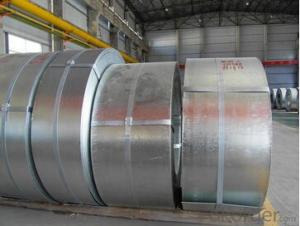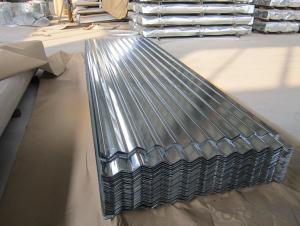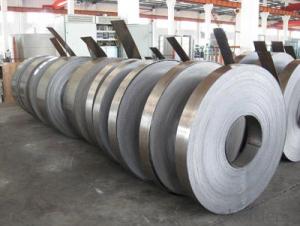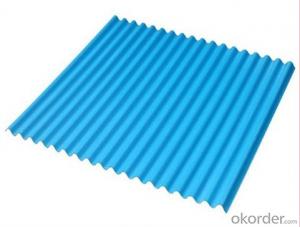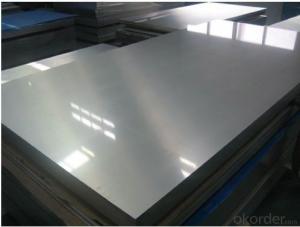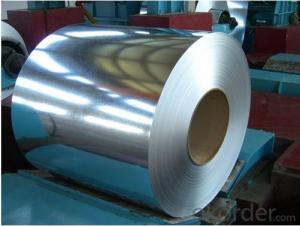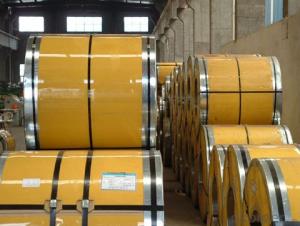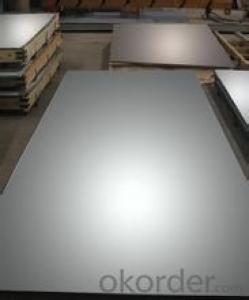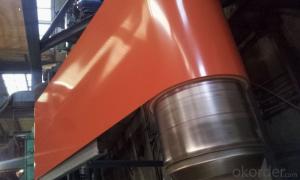Cold Rolled Steel Coil JIS G 3302 Walls Steel Coil ASTM 615-009
- Loading Port:
- Tianjin
- Payment Terms:
- TT OR LC
- Min Order Qty:
- 2222 kg/m²
- Supply Capability:
- 11 kg/m²/month
OKorder Service Pledge
OKorder Financial Service
You Might Also Like
1.Structure of Cold Rolled Steel Description:
The raw material of cold rolled steel coil/sheet is high quality hot rolled product, and after pickling continuous rolling, degreasing, annealing,skin pass,slitting and cut to length line etc. Along with it many kinds of new technology and new process of global cold rolling production have been applied. Therefore the quality of the goods could be guaranteed. The product is widely used in outdoor and interior decoration, furnishing manufacturing, home appliance, automobile etc. it has a lower melting point than steel and good castability properties.[1] Certain compositions of cast iron, while retaining the economies of melting and casting, can be heat treated after casting to make malleable iron or ductile iron objects. Steel is also distinguishable from wrought iron (now largely obsolete), which may contain a small amount of carbon but large amounts of slag.
2.Main Features of the Cold Rolled Steel:
• Excellent process capability
• Smooth and flat surface
• Workability, durability
• Excellent heat resistance performance
• High strength
• Good formability
• Good visual effect
Community portal – Bulletin board, projects, resources and activities covering a wide range of Wikipedia areas.
Help desk – Ask questions about using Wikipedia.
Local embassy – For Wikipedia-related communication in languages other than English.
Reference desk – Serving as virtual librarians, Wikipedia volunteers tackle your questions on a wide range of subjects.
Site news – Announcements, updates, articles and press releases on Wikipedia and the Wikimedia Foundation.
Village pump – For discussions about Wikipedia itself, including areas for technical issues and policies.
3.Cold Rolled Steel Images

4.Cold Rolled Steel Specification
Standard:AISI,ASTM,DIN,GB,JIS,JIS G3302 ASTM 653M EN10142
Grade: Q195~Q345
Thickness: 0.16mm~1.5mm,0.16-1.5mm
Width: 1250,600-1250mm
Coil weight:3-12 MT
Coil ID:508/610mm
Chemical composition:
C | Si | Mn | Cr | Ni | P | S |
0.150 | 0.476 | 11.231 | 12.50 | 0.900 | 0.039 | 0.010
|
5.FAQ of Cold Rolled Steel
We have organized several common questions for our clients,may help you sincerely:
1.How about your company?
A world class manufacturer & supplier of castings forging in carbon steel and alloy steel,is one of the large-scale professional investment casting production bases in China,consisting of both casting foundry forging and machining factory. Annually more than 8000 tons Precision casting and forging parts are exported to markets in Europe,America and Japan. OEM casting and forging service available according to customer’s requirements.
2.How to guarantee the quality of the products?
We have established the international advanced quality management system,every link from raw material to final product we have strict quality test;We resolutely put an end to unqualified products flowing into the market. At the same time, we will provide necessary follow-up service assurance.
3. How long can we receive the product after purchase?
Usually within thirty working days after receiving buyer’s advance payment or LC. We will arrange the factory manufacturing as soon as possible. The cargo readiness usually takes 15-25 days, but the shipment will depend on the vessel situation.
- Q:How are steel strips processed for fire resistance?
- Steel strips can be processed for fire resistance using several methods. One common method is to apply a fire-resistant coating to the surface of the steel strip. This coating is designed to provide a protective barrier that can withstand high temperatures and prevent the steel from reaching its critical temperature, which is the temperature at which it loses its structural integrity. The fire-resistant coating can be applied through various techniques such as spray coating, dip coating, or electrostatic deposition. Another method of processing steel strips for fire resistance is through the application of intumescent coatings. These coatings are designed to expand when exposed to high temperatures, forming a thick and insulating layer that acts as a shield against heat transfer. Intumescent coatings can be applied as a paint or a thin film on the surface of the steel strip. Additionally, steel strips can also be processed for fire resistance through the use of fire-resistant insulation materials. These materials are applied to the steel strip to provide additional insulation and protection against heat. Insulation materials can include mineral wool, ceramic fiber, or vermiculite boards, which are known for their high resistance to fire. It is important to note that the specific process of fire resistance for steel strips may vary depending on the intended application and the required level of fire protection. Therefore, it is essential to consult with experts in the field of fire protection to determine the most suitable method of processing steel strips for fire resistance in a particular scenario.
- Q:Are steel strips used in the production of oil and gas equipment?
- Yes, steel strips are commonly used in the production of oil and gas equipment. Steel strips are often utilized in the fabrication of various components, such as pipes, valves, fittings, and pressure vessels, that are essential in the oil and gas industry. The high strength and durability of steel make it an ideal material for withstanding the harsh conditions encountered in oil and gas operations. Additionally, steel strips can be easily formed, welded, and machined to meet specific design requirements, making them suitable for a wide range of applications in the industry.
- Q:What are the alloying elements found in steel strips?
- The composition of alloying elements in steel strips varies depending on the grade and intended use of the steel. However, several alloying elements commonly found in steel strips are carbon, manganese, silicon, phosphorus, sulfur, chromium, nickel, and molybdenum. Of these elements, carbon is the most crucial as it provides strength and hardness to the steel. Manganese is frequently added to improve the hardenability and tensile strength of the steel strips. Silicon is utilized to enhance the steel's resistance to oxidation and enhance its electrical properties. Although phosphorus and sulfur are usually present in small amounts, they can affect the machinability and brittleness of the steel. Chromium is incorporated to boost the steel's corrosion resistance and its strength at elevated temperatures. Nickel is employed to enhance the toughness and ductility of the steel, particularly in low-temperature applications. Molybdenum is often added to increase the steel's strength, hardness, and resistance to corrosion. Depending on the desired properties of the steel strips, other alloying elements such as vanadium, titanium, copper, and aluminum may also be present. In summary, the alloying elements in steel strips are meticulously chosen to achieve specific mechanical, physical, and chemical properties, making the steel suitable for a wide range of applications in various industries.
- Q:What are the different surface coatings available for steel strips to improve heat resistance?
- There are several different surface coatings available for steel strips to improve heat resistance, including zinc-based coatings such as galvanizing and zinc-aluminum alloys, ceramic coatings, and specialized high-temperature coatings like aluminized coatings and thermal spray coatings. These coatings provide a protective barrier that enhances the steel's ability to withstand high temperatures and prevent oxidation and corrosion.
- Q:Can steel strips be used for making coins?
- Steel strips cannot be utilized in the production of coins. Generally, coins are forged from metals like copper, nickel, or zinc, which possess favorable qualities such as resilience, flexibility, and resistance to rust. Conversely, steel, being predominantly an amalgamation of iron and carbon, is not commonly employed in coin manufacturing due to its hardness and vulnerability to corrosion. Furthermore, coins crafted from steel strips would lack the requisite weight and tactile sensation typically associated with coins, rendering them less preferable for daily transactions.
- Q:Are steel strips flexible?
- No, steel strips are not flexible.
- Q:Are steel strips used in the production of automotive chassis components?
- Yes, steel strips are commonly used in the production of automotive chassis components. Steel strips are preferred due to their high strength and durability, making them suitable for supporting the weight of the vehicle and providing structural integrity. These strips can be formed and welded into various shapes and sizes to meet the specific requirements of different chassis components, such as frame rails, cross members, and suspension mounting points. Steel strips also offer excellent corrosion resistance, reducing the risk of rusting and extending the lifespan of the chassis components. Additionally, steel strips are cost-effective and readily available, making them a popular choice in the automotive industry for chassis production.
- Q:Are steel strips suitable for the manufacturing of electrical motors?
- Yes, steel strips are suitable for the manufacturing of electrical motors. Steel strips are commonly used as a core material in the construction of electrical motors due to their excellent magnetic properties, high strength, and durability. They provide a solid base for the winding and help in enhancing the motor's efficiency and performance.
- Q:What are the tolerances for dimensional accuracy of steel strips?
- The tolerances for dimensional accuracy of steel strips can vary depending on the specific application and industry standards. However, common tolerances for dimensional accuracy range from +/- 0.005 inches to +/- 0.015 inches, with tighter tolerances often required for precision applications such as automotive or aerospace industries.
- Q:Can steel strips be used in the production of firearms?
- Yes, steel strips can be used in the production of firearms. Steel is a commonly used material in firearm manufacturing due to its strength, durability, and ability to withstand high pressure and heat. Steel strips can be shaped and machined to create various firearm components such as barrels, slides, frames, and triggers.
1. Manufacturer Overview |
|
|---|---|
| Location | |
| Year Established | |
| Annual Output Value | |
| Main Markets | |
| Company Certifications | |
2. Manufacturer Certificates |
|
|---|---|
| a) Certification Name | |
| Range | |
| Reference | |
| Validity Period | |
3. Manufacturer Capability |
|
|---|---|
| a)Trade Capacity | |
| Nearest Port | |
| Export Percentage | |
| No.of Employees in Trade Department | |
| Language Spoken: | |
| b)Factory Information | |
| Factory Size: | |
| No. of Production Lines | |
| Contract Manufacturing | |
| Product Price Range | |
Send your message to us
Cold Rolled Steel Coil JIS G 3302 Walls Steel Coil ASTM 615-009
- Loading Port:
- Tianjin
- Payment Terms:
- TT OR LC
- Min Order Qty:
- 2222 kg/m²
- Supply Capability:
- 11 kg/m²/month
OKorder Service Pledge
OKorder Financial Service
Similar products
New products
Hot products
Hot Searches
Related keywords
